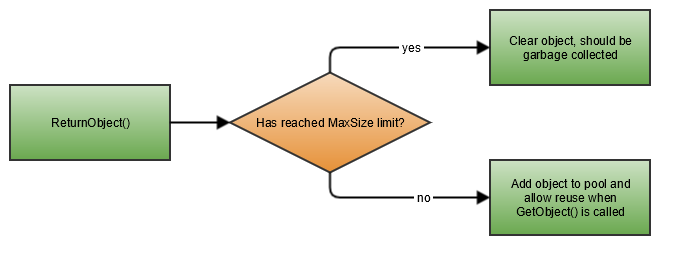Pooling
Garbage collection in .NET can be very expensive, especially for objects on the Large Object Heap (LOH). .NET itself already uses pooling for threads to prevent the costly creation of threads but instead re-uses the already created threads using a thread pool. Catel provides an implementation of pooling using the PoolManager<TPoolable>. This allows both Catel and third party developers to create a pool for large objects so they can be reused.
The documentation uses a byte array of 4096 as poolable object as example. If _poolManager is used in the code below, it represents an instance of PoolManager<Buffer4096Poolable>
Introduction to the pool manager
The pool manager internally uses a stack to manage the available objects in the pool. It’s important to understand how a pool works. The flow diagram below shows how the pool manager deals with objects:

It is recommended that a pool manager gets registered in the ServiceLocator so it can be re-used by multiple components.
Note that the pool manager does not limit the number of objects in memory. It has a MaxSize property so it will store only a maximum amount of objects inside the internal pool, but if the pool is running out of instances and a new object is requested, it will return a new instance (and thus creating a new object which could be garbage collected).
Retrieving objects from the pool
Retrieving an object from the pool is very simple. When an instance of the PoolManager<TPoolable> is available, use the code below:
var poolableBuffer = _poolManager.GetObject();
The PoolManager<TPoolable> will automatically create a new object when no objects are available in the pool.
Returning objects to the pool
Objects should be automatically returned to the pool when the objects are disposed. This means the objects are not really disposed but the state is being reset and the object is being returned to the pool. To automatically take care of this, it’s best to use the PoolManager<TPoolable> as shown below:
using (var poolableBuffer = _poolManager.GetObject())
{
var buffer = poolableBuffer.Data;
// work with the buffer here
}
// outside the scope, the object is automatically disposed and returned to the pool
The flow chart below shows how the PoolManager<TPoolable> will handle the dispose:

Customizing a pool manager
Catel implements pooling via the PoolManager<TPoolable> class. This class allows the caller to retrieve an object. There is no need to explicitly derive a class from the PoolManager<TPoolable>. It can be customized though.
Customizing the maximum size
By default, the PoolManager<TPoolable> uses a maximum size of 5 MB per poolable type. If, for this example, the maximum size of byte buffers should be 1 MB, use the code below:
var poolManager = new PoolManager<Buffer4096Poolable>();
poolManager.MaxSize = 1024 * 1024 * 1;
If the MaxSize is reached, objects will not be added back to the internal pool but be left out and, if no other references exist to this object, be ready for garbage collection.
Creating a poolable object
Since the objects need to be re-used, it’s very important that the PoolManager<TPoolable> knows how to reset objects to the initial state. Therefore every poolable object needs to implement IPoolable which also implements IDisposable. Below is an example implementation of a poolable object.
public class Buffer4096Poolable : IPoolable
{
private const int BufferSize = 4096;
protected IPoolManager _poolManager;
public Buffer4096Poolable()
{
Data = new byte[BufferSize];
}
public byte[] Data { get; private set; }
public int Size { get { return BufferSize; } }
public void Reset()
{
var buffer = Data;
Array.Clear(buffer, 0, buffer.Length);
}
// Implemented explicitly so it can't be called accidentally
void IPoolable.SetPoolManager(IPoolManager poolManager)
{
_poolManager = poolManager;
}
public void Dispose()
{
_poolManager.ReturnObject(this);
}
}
Contributions
We would like to thank the following contributors:
Want to contribute to the documentation? We have a guide for that!
Questions
Have a question about Catel? Use StackOverflow with the Catel tag!